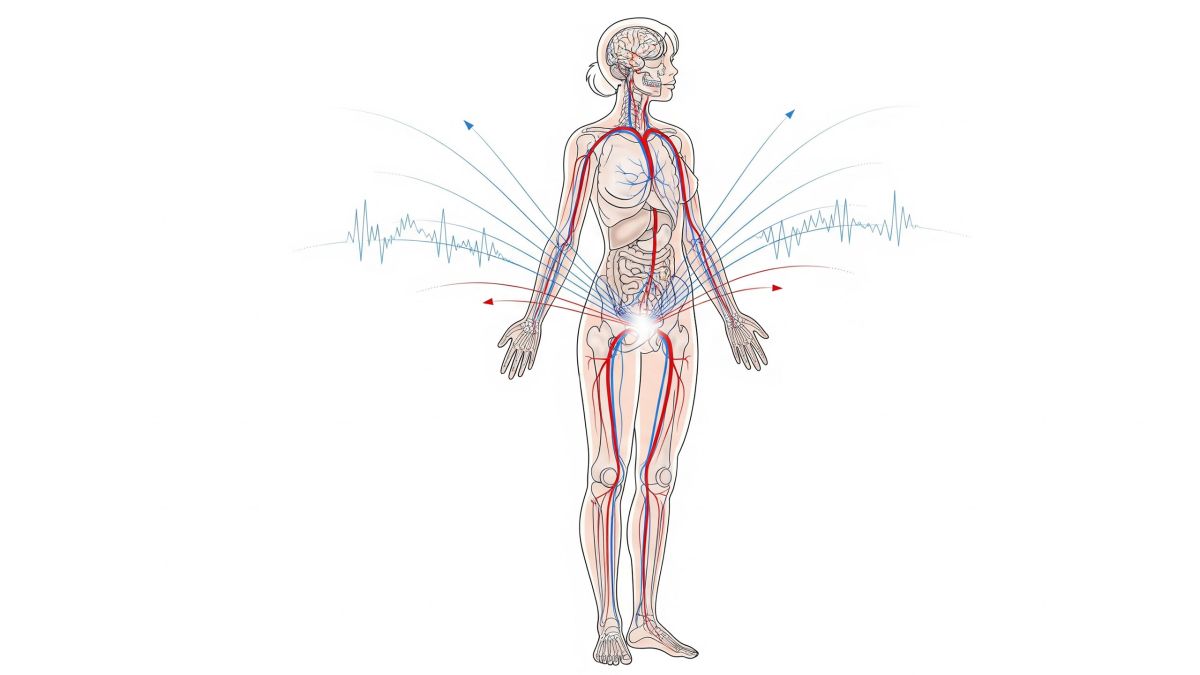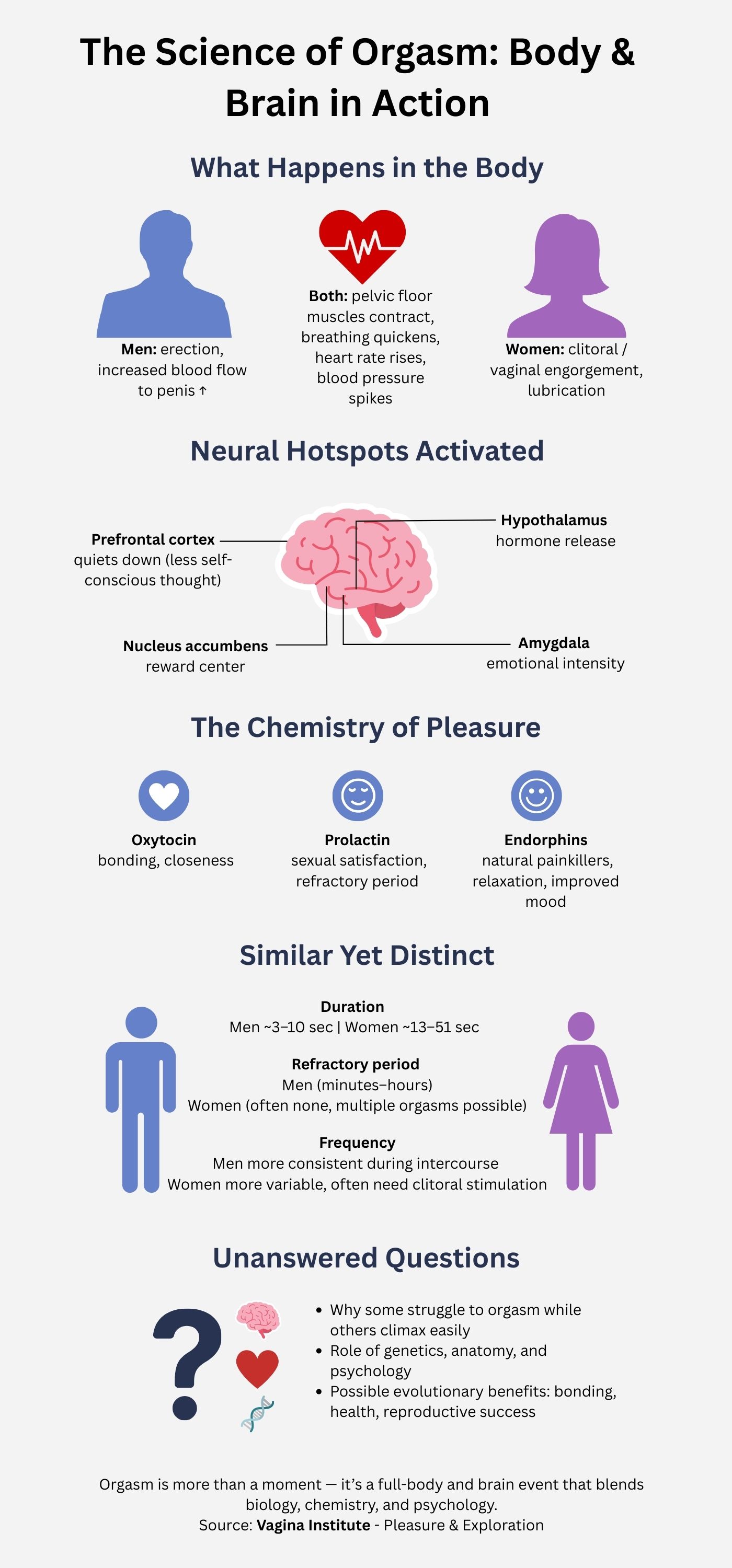The Science of Orgasm: What Happens in the Body and Brain

Few human experiences are as universal yet as complex as orgasm. Though often framed in cultural or personal terms, science provides fascinating insights into what happens in the body and brain during this peak of sexual response. Far from being only a fleeting sensation, orgasm involves a cascade of biological, neurological, and psychological processes that researchers are still mapping out.
The Physical Build-Up
An orgasm doesn’t occur in isolation; it’s the culmination of arousal. When sexual stimulation begins, blood flow to the genitals increases. In women, this leads to lubrication and swelling of the clitoris, labia, and vaginal walls. In men, it causes erection through the engorgement of erectile tissue.
Muscles throughout the pelvic floor tighten rhythmically, setting the stage for the involuntary contractions that characterize orgasm itself. Heart rate, blood pressure, and breathing all accelerate—essentially priming the body for an intense burst of energy release.
The Neurological Orchestra
The brain is the true control center of orgasm. Sensory nerves transmit signals from erogenous zones to the spinal cord and onward to the brain. Functional MRI scans show that areas involved in reward, memory, emotion, and motor control light up during climax.
Key players include:
-
The hypothalamus, which regulates hormone release.
-
The amygdala, linked to emotional intensity.
-
The nucleus accumbens, part of the brain’s reward circuitry.
-
The prefrontal cortex, the seat of rational thought, which tends to quiet down as orgasm approaches—allowing for less self-consciousness and more raw sensation.
This interplay results in a short-lived but powerful neurological fireworks show, blending physical pleasure with psychological release.

Hormonal Release
Orgasm sparks a surge of hormones. Oxytocin, often called the “bonding hormone,” floods the bloodstream, contributing to feelings of closeness and relaxation. Prolactin, associated with sexual satisfaction, spikes after climax and may play a role in the refractory period (the recovery phase before arousal is possible again). Endorphins, the body’s natural painkillers, enhance mood and promote a sense of well-being.
For both men and women, these chemical shifts explain why orgasm doesn’t just feel good in the moment but can also improve mood, ease stress, and even help with sleep.
The Psychological Dimension
While biology explains the mechanics, psychology shapes the experience. Mental state, comfort level, and partner connection can all affect whether orgasm is reached and how it feels. Stress, distraction, or performance anxiety can dampen the brain’s ability to respond to stimulation, while relaxation and trust can enhance it.
Interestingly, research shows that the brain can trigger orgasm even without direct physical stimulation, such as through fantasy, memory, or certain meditative practices. This underscores how deeply mind and body intertwine in sexual experience.
Male and Female Differences in Orgasm
Though the fundamental physiology is similar, men and women experience orgasms with distinct patterns.
Duration and Intensity
-
Men generally experience shorter orgasms, lasting between 3–10 seconds on average.
-
Women often report longer-lasting orgasms, typically between 13–51 seconds, and sometimes describe waves of pleasure rather than a single peak.
Frequency
-
Men usually reach orgasm more consistently during intercourse.
-
Women may require different types of stimulation (clitoral, vaginal, or both) and report greater variation in how easily orgasm is achieved.
Refractory Period
-
Men typically enter a refractory period immediately after orgasm, during which achieving another erection or orgasm is physiologically impossible. This period can last minutes to hours depending on age, health, and arousal level.
-
Women, by contrast, often have little to no refractory period and may experience multiple orgasms in succession if stimulation continues.
Multiple Orgasms
-
Men can sometimes experience multiple orgasms, but this is less common and often requires specific techniques or practice.
-
Women are more likely to report multiple orgasms naturally, especially when clitoral and vaginal stimulation are combined.
Quick comparison: Male vs. Female Orgasm
| Feature | Men | Women |
|---|---|---|
| Typical duration | Often 3–10 seconds | Often longer; 13–51 seconds reported; may occur as waves |
| Frequency during intercourse | Generally consistent | More variable; may require clitoral or combined stimulation |
| Refractory period | Common; lasts minutes to hours (age-dependent) | Often minimal or absent; multiple orgasms possible |
| Hormonal spikes | Oxytocin, prolactin, endorphins also increase | Oxytocin, prolactin, endorphins also increase |
| Multiple orgasms | Less common; possible with practice/technique | More commonly reported, especially with continued stimulation |
Orgasm Across the Spectrum
Not all orgasms are alike. Women may experience clitoral, vaginal, or blended orgasms, while men typically climax through penile stimulation. Both men and women can also reach orgasm through anal stimulation, and some report “full-body” orgasms that extend sensations beyond the pelvic region.
These variations suggest that the nervous system’s wiring allows for a wide range of experiences, with individual differences shaping what feels most satisfying.
What Science Still Doesn’t Fully Know
Despite decades of research, orgasm remains partly mysterious. Why some men and women struggle to reach it while others climax with relative ease isn’t entirely understood. Individual differences in anatomy, psychology, and even genetics likely all contribute.
We will continue to explore whether orgasms provide evolutionary advantages beyond reproduction—such as promoting bonding or encouraging sexual activity that improves overall health.
The Takeaway
Orgasm is far more than a momentary sensation. It’s a complex symphony of physical arousal, brain activity, hormone release, and psychological context. Men and women may experience orgasms differently in duration, frequency, and recovery, but the underlying processes highlight just how intricate and rewarding human sexuality can be.
Reader Q&A
A: Orgasms are not strictly necessary for sexual health, but they often bring mood benefits, stress reduction, and improved sleep due to hormonal release. Sexual satisfaction can take many forms beyond orgasm.
A: The refractory period is linked to hormonal shifts (including prolactin) and nervous system recovery after ejaculation. Its length varies by age, health, and individual physiology.
A: Yes—some women reach orgasm through vaginal stimulation, mental arousal, or other erogenous zones. Many report that combined clitoral and vaginal stimulation is most reliable.
A: Research suggests short-term benefits (stress relief, mood improvement, better sleep). Studies on long-term outcomes are ongoing; sexual health contributes to overall quality of life but is one factor among many.
A: Open communication, experimentation with different types of stimulation, reducing performance pressure, and consulting a sexual health professional if concerns persist are common next steps.
Disclaimer: The articles and information provided by the Vagina Institute are for informational and educational purposes only. This content is not intended to be a substitute for professional medical advice, diagnosis, or treatment. Always seek the advice of your physician or another qualified health provider with any questions you may have regarding a medical condition.


 English
English  Deutsch
Deutsch  Español
Español  Français
Français 




